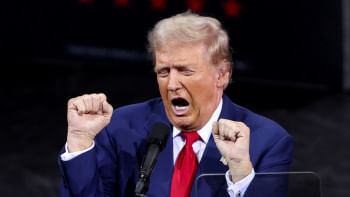Swadhin Bangla Betar Kendra

I
Dacca, Thursday March 25, 1971. Operation Searchlight. Pakistan starts a systematic war on its own people, beginning in University of Dacca. A just cause in East Pakistan became a peoples' war overnight. The wheels of history are set into motion.
Chittagong, Friday March 26, 1971. 2.15 PM. Badamtali Betar Kendra, Agrabad. MA Hannan, Awami League leader, reads out Bangabandhu's speech from March 7, 1971 and declaration of independence over radio.
Chittagong, Friday March 26, 1971. 7.40 PM. Belal Mohammad, Abul Kashem Sandwip and Syed Abul Kahhar decide to broadcast programmes. For security, the Kalurghat emergency studio outside Chittagong city is used. The journey of Swadhin Bangla Biplobi Betar Kendra starts. "Biplobi" is later omitted.
Chittagong, Saturday March 27, 1971. Major Ziaur Rahman 'on behalf of Bangabandhu Sheikh Mujibur Rahman' declared 'that the independent People's Republic of Bangladesh has been established'.
Chittagong, Tuesday March 30, 1971. 2.10 PM approx. Kalurghat radio station is bombed. Phase I of Swadhin Bangla Betar Kendra (SBBK) ends.
The founders of SBKK disperse towards Tripura.
II
Bangabandhu was in custody in Pakistan. The Mujibnagar Government couldn't function freely within Bangladesh. A platform was needed through which the war could be conducted.
The war also needed a platform that could reach out to the sixty-five million people inside Bangladesh, and the ten million in neighbouring states of India. The war needed a platform to let the outside world be aware of the situation.
The stage was set for SBBK to echo its way into history.

III
Tripura, Saturday April 3, 1971. 9.00 PM. First broadcast of SBBK from BSF 92 Headquarters in Bagafa, Tripura. Tripura aided with a 200W Short Wave Transmitter.
Tripura, Thursday April 8, 1971. SBBK moved to BSF 91 Headquarters in Agartala, the capital of Tripura. Broadcasting started with a 400W Short Wave and a 1KW Medium Wave Transmitter. This centre broadcasted SBBK programmes until Monday May 24, 1971. Within this time, Tajuddin Ahmad's April 11 speech and the oath-taking ceremony of the Mujibnagar Government on April 17 were relayed from Agartala. It was now time for SBBK to move to Calcutta. End of Phase II.
IV
Calcutta, 57/8 Ballygunge Circular Road. If there were eleven sectors in the battlefield, this house was the twelfth sector; it existed in the soundwaves.
Tuesday May 25, 1971. The birth anniversary of Kazi Nazrul Islam. And with it, SBBK started Phase III.
The two most popular programmes were Jallader Darbar (a satirical play on Yahya Khan) and Charam Patra (a satirical talk). These two programmes were pivotal in boosting the morale of the people in Bangladesh and those in India.
The legacy of SBBK is in its songs of freedom. SBBK was the only point of contact for an entire nation to keep up with the war. The thread that bonded the nation were its songs of freedom.
Joy Bangla, Banglar Joy; Karar Oi Louha Kopat; Teer Hara Oi Dheu-er Sagar; Purba Digonte; More Ekti Phoolke Bachabo Bole Juddho Kori; Shono Ekti Mujibor-er Theke; Ek Sagar Rokter Binimoye; Salaam, Salaam, Hajar Salaam; Nongor Tolo Tolo; Maago, Bhabna Keno and many more songs and tunes resonated through the green fields of Bengal in Bangladesh and the Bangla-speaking places in India where the people of Bangladesh had found refuge.
The songs came from the heart of its composers, lyricists, singers and all the people involved with SBBK.
V
Why did the people of India shelter Bangladesh? Simple. Only twenty-four years before, in 1947, Bengal was partitioned forever. People of Purba Bangla, what first became East Pakistan, and then Bangladesh, left their homesteads forever to find shelter in India.
When they heard, the people of Purba Bangla came to India for refuge, the thread of the nareer taan came back. It had to. They had to give back to the land they were born in, or at least where a part of their family came from.
Gouriprasanna Mazumder (Pabna), Shyamal Gupta, Shibdas Bandyopadhyay (Khulna), Sachin Dev Burman (Comilla), Meera Dev Burman (Dacca), Manabendra Mukhopadhyay (Barisal), Debabrata Biswas (Mymensingh), and many others jumped at the opportunity to help their Purba Bangla through SBBK.
SBBK songs were not only aired, they were also performed in the refugee camps by the artistes of Bangladesh and India.
That was the first and the last time, the two Bengals and Tripura united with love for each other. It was the songs of freedom of SBBK that made the emergence of Bangladesh ever so worthwhile.
VI
Very few nations have had the privilege of fighting a war of independence. Bangladesh had that privilege. Bangladesh also had the privilege of the love of its own people who sheltered their own in the refugee camps and helped however they could. Swadhin Bangla Betar Kendra was one of the threads that gelled the people of Bengal. When another day comes, and the need arises, the songs will come back to guide and give hope.
Asrar Chowdhury teaches Economics in classrooms. Outside, he watches Test cricket, plays the flute and listens to music and radio podcasts. Email: asrarul@juniv.edu or asrarul@gmail.com


 For all latest news, follow The Daily Star's Google News channel.
For all latest news, follow The Daily Star's Google News channel. 



Comments